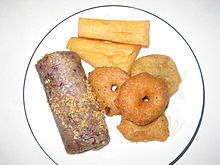 A plate of Burmese fritters | |
| Course | Breakfast, snack (mont) |
|---|---|
| Place of origin | Myanmar (Burma) |
| Region or state | Southeast Asia |
| Associated cuisine | Burmese |
| Main ingredients | Various |
| Similar dishes | Vada, tempura, pakora, okoy, pholourie, bakwan |
Burmese fritters (Burmese: အကြော်; pronounced [ʔət͡ɕɔ̀]; known as a-kyaw in Burmese) are traditional fritters consisting of vegetables or seafood that have been battered and deep-fried. Assorted fritters are called a-kyaw-sone (Burmese: အကြော်စုံ). Burmese fritters are generally savory, and often use beans and pulses, similar to South Asian vada.
The fritters are eaten mainly at breakfast or as a snack at teatime, served at tea shops and hawker stands alike.[1] They are typically served as standalone snacks dipped in a sour-sweet tamarind-based sauce, or as toppings for common Burmese dishes. Gourd, chickpea and onion fritters are cut into small parts and eaten with mohinga, Myanmar's national dish. These fritters are also eaten with kauk hnyin baung rice and with a Burmese green sauce called a-chin-yay (အချဉ်ရည်). Depending on the fritter hawker, the sauce is made from chili sauce diluted with vinegar, water, cilantro, finely diced tomatoes, garlic and onions.


